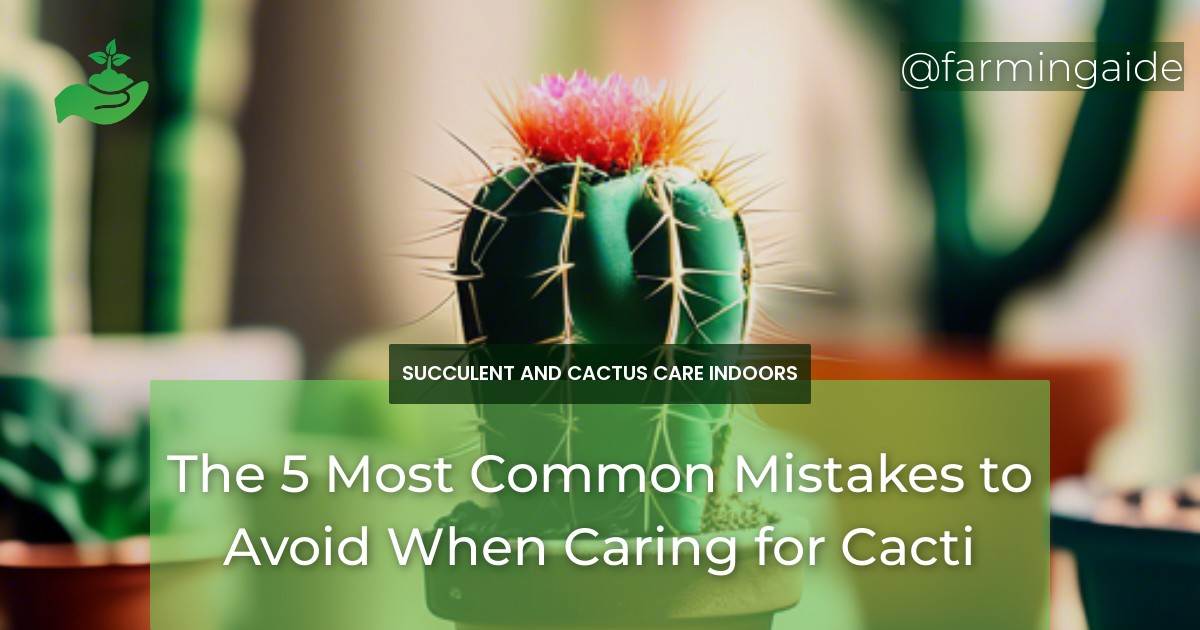Are you tired of watching your cacti wither away, despite your best efforts to care for them? You’re not alone! Many well-intentioned cacti enthusiasts make the same common mistakes that can lead to the demise of their prickly friends. In this article, we’ll explore the top 5 mistakes to avoid when caring for cacti, so you can give your plants the best chance to thrive.
Key Takeaways
- Avoid overwatering, which can lead to root rot and kill your cacti.
- Provide adequate sunlight, as cacti need UV rays to photosynthesize.
- Use well-draining soil to prevent waterlogged soil conditions.
- Maintain optimal temperature ranges, as cacti are sensitive to extreme temperatures.
- Fertilize sparingly, as overfertilization can damage your cacti.
Introduction to Cacti Care
Cacti have adapted to survive in harsh desert environments, but this doesn’t mean they’re immune to neglect or poor care. In fact, cacti require specific conditions to thrive, and neglecting these needs can lead to disease, pests, or even death. By understanding the unique requirements of cacti, you can provide the best possible care for your plants.
Before we dive into the common mistakes to avoid, let’s cover the basics of cacti care. Cacti need:
Understanding Cacti Needs
Water: Cacti need occasional watering, but overwatering is a common mistake. Water sparingly, allowing soil to dry out between waterings.
Sunlight: Cacti need UV rays to photosynthesize, so place them in a sunny spot with filtered sunlight.
Soil: Use well-draining soil to prevent waterlogged soil conditions.
Temperature: Maintain optimal temperature ranges, as cacti are sensitive to extreme temperatures.
Common Misconceptions About Cacti Care
Many new cacti owners assume that these plants are low-maintenance and can thrive in any environment. However, this couldn’t be further from the truth. Cacti require specific care, and neglecting these needs can lead to disaster.
Another common misconception is that cacti can survive without water. While they can survive for extended periods without water, cacti still need occasional watering to thrive.
Mistake #1: Overwatering Your Cacti
Overwatering is one of the most common mistakes when caring for cacti. Cacti have adapted to store water in their stems, so they don’t need frequent watering. In fact, overwatering can lead to root rot, a common cause of death in cacti.
ALSO READ
Signs of Overwatering
Soft, mushy stems
Water pooling around the base of the plant
Rapid growth, followed by sudden decline
Correct Watering Techniques
Water sparingly, allowing soil to dry out between waterings.
Check the soil moisture by sticking your finger into the soil up to the first knuckle. If the soil feels dry, it’s time to water.
Avoid getting water on the leaves or stems to prevent rot and fungal infections.
Mistake #2: Inadequate Sunlight Exposure
Cacti need UV rays to photosynthesize and thrive. Without adequate sunlight, your cacti may become weak and leggy.
ALSO READ
Importance of Sunlight for Cacti
Cacti use sunlight to produce energy through photosynthesis.
Sunlight helps regulate the plant’s internal clock, promoting healthy growth and development.
Optimal Lighting Conditions
Place cacti in a sunny spot with filtered sunlight, such as an east- or west-facing window.
Avoid direct sunlight, which can cause burning and scorching.
Mistake #3: Using the Wrong Soil Type
Using the wrong soil type can lead to waterlogged soil conditions, root rot, and eventually, death.
Ideal Soil Composition for Cacti
Use a well-draining potting mix specifically designed for cacti and succulents.
Avoid using regular potting soil, as it can retain too much water and cause root rot.
Common Soil Mistakes
Using regular potting soil
Not repotting cacti regularly to refresh the soil
Mistake #4: Neglecting Temperature Requirements
Cacti are sensitive to extreme temperatures, which can cause stress, disease, or even death.
Ideal Temperature Ranges for Cacti
Most cacti thrive in temperatures between 65°F to 75°F (18°C to 24°C).
Some species, like Christmas cacti, prefer cooler temperatures around 50°F to 60°F (10°C to 16°C).
Seasonal Temperature Adjustments
Adjust the temperature according to the season.
During the winter months, reduce temperatures to 50°F to 60°F (10°C to 16°C) to promote dormancy.
Mistake #5: Overfertilization
Overfertilization can damage your cacti, leading to weak and leggy growth.
Risks of Overfertilization
Burning of roots and stems
Weakened immune system, making cacti more susceptible to disease
Proper Fertilization Practices
Fertilize sparingly, as cacti don’t require frequent feeding.
Use a balanced, water-soluble fertilizer during the growing season (spring and summer).
Conclusion and Final Tips for Thriving Cacti
By avoiding these common mistakes, you can give your cacti the best chance to thrive. Remember to:
Water sparingly and avoid overwatering.
Provide adequate sunlight, but avoid direct sunlight.
Use well-draining soil and repot regularly.
Maintain optimal temperature ranges and adjust according to the season.
Fertilize sparingly and avoid overfertilization.
With proper care and attention, your cacti will flourish, and you’ll be rewarded with beautiful, thriving plants.


